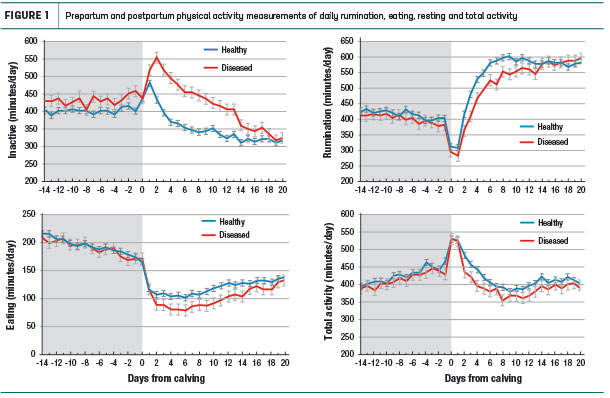Postpartum disease and disorders may pose a threat to dairy cows, negatively affecting culling, lactation and reproductive performance. Approximately one-third of dairy cows have at least one clinical disease (e.g., metritis, mastitis, digestive issues and respiratory problems) during the first three weeks of lactation.
Transition from pregnancy to lactation poses the greatest risk for culling or even death in dairy cows.
Background
Dairy cows cannot consume enough feed after calving to meet the nutrient demands of milk production. As a result, cows are in negative energy balance (i.e., energy input obtained from the diet is less than the energy output of harvested milk). To compensate for this negative energy balance, free fatty acids (FFA) or sometimes called nonesterified fatty acids or NEFA, are released from bodyfat storage sites as the cow attempts to supplement insufficient energy intake.
These FFA are taken up by the liver and various energy sources are produced, such as glucose. When the liver is overwhelmed with large concentrations of FFA, the liver produces ketone bodies such as acetone and beta-hydroxybutyrate (BHB). Elevated concentrations of BHB are consistent with clinical and subclinical ketosis. Elevated concentrations of BHB that are insufficient to cause clinical ketosis are generally found in a significant proportion of cows; thus, subclinical ketosis also is problematic and may predispose cows to other postpartum disease.
Milk contains large concentrations of calcium and, of course, calcium also is needed for normal muscle contractions. Cows have inadequate blood calcium because they cannot absorb enough dietary calcium, which is then supplemented by reabsorbing calcium from bone tissue. When blood calcium is insufficient, cows become recumbent with milk fever. Even when these extremes do not occur, cows that have low blood calcium are more prone to other disease.
Haptoglobin is a protein produced by the liver, and elevated blood haptoglobin is observed in response to tissue damage, inflammation, infection and bacterial components. Glucose decreases immediately after calving because of the large demand for glucose to synthesize milk.
We recently conducted a study of 160 Holstein cows with the objective to characterize associations between transition diseases and multiple physical and metabolic indicators of cow status during the transition and postpartum period.
Prospective study
Routine daily monitoring of close-up dry cows and late-gestation heifers took place in addition to documenting health disorders according to common definitions. Other factors such as body condition, bodyweight, rectal temperature and blood metabolites were monitored as well. Concentrations of glucose, FFA, BHB, haptoglobin and calcium were measured in samples collected on postpartum days zero, 3, 7 and 14. Blood also was collected weekly to determine when first postpartum ovulation occurred based on a significant increase in concentrations of serum progesterone. In addition, Cow SensOor eartags were affixed to cows and heifers during mid-gestation to assess daily physical activities.
Study findings
We found that 42.5% of cows had at least one case of diagnosed metritis, digestive disorders, ketosis, hypocalcemia, calving problems, mastitis or lameness during the first 60 days after calving. We observed that cows with disease status had greater concentrations of blood FFA, BHB and haptoglobin; less blood calcium and greater rectal temperatures compared with healthy cows on postpartum days zero, 3, 7 and 14. Prebreeding body condition scores and bodyweights recovered sooner and were greater in healthy cows by first insemination (postpartum days 70 to 76).
We found that 57.5% of healthy cows ovulated the first time by day 33 after calving compared with only 42.5% of diseased cows. Stated differently, disease delayed first postpartum ovulation, such that the odds for having delayed ovulation were 1.9 times greater in diseased cows than in healthy cows. Last but not least, healthy cows produced more daily milk during the first 14 weeks after calving compared with diseased cows (103 versus 98 pounds per day), respectively.
Very unique to these findings were our observations about prepartum and postpartum physical activities, which included measures of daily rumination, eating, resting and total activity (Figure 1).

Cows diagnosed with disease were less active (rested more) during the prepartum and postpartum periods than healthy cows. Prepartum rumination times were unaffected by health status but were greater in healthy than diseased cows after calving. Eating times were not affected by health status during either period, but an acute decrease in prepartum eating time was evident during the last 24 hours before calving, reaching the lowest points on days 4 to 6 in healthy and diseased cows but at a lower point in diseased cows. Thereafter, eating time increased slowly in all cows.
Prepartum total daily activity was not affected by health status but, after calving, healthy cows tended to have greater overall activity than diseased cows. Postpartum total daily activity was greater in first-lactation cows than in older cows (443.3 plus or minus 8.3 versus 382.8 plus or minus 8.5 minutes per day, respectively) during the study (November through August). Acute changes in all activities were associated with calving and could serve as predictors of impending parturition based on abrupt decreases in rumination and acute increases in total activity.
We concluded that disease negatively affects postpartum metabolic profiles and days to first postpartum ovulation. Incidence of disease is associated with measurable changes in physical activity. More research is needed to determine how various behavioral activities may be correlated and even predictive of specific transition diseases in dairy cows.






